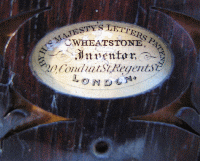| Previous | Section Summary | Help | Next |
Item Type: Concertina
| Summary | Labels and Serial Numbers | End Frets | Fingering System | Straps and Holding Devices | Fret Baffle | Action Board | Reeds and Reed Pans | Bellows | Case and Other |
Summary
Full Description: An 1841 period 44-key Wheatstone English system, No 430, with additional new features showing the final stages of the progression to what may be called the "Standard" Wheatstone 48-key design. This model has 22 keys each side (not yet in the later 48-key format). The accidental keys are black-stained (not cored) in common with most later instruments, and in for the first time, the keys have their lower ends turned to create an integral ivory pin which enter the action board. The action board is divided into an upper fretwork layer (frets now integral with the top half of the end-frames) and a lower frame encircling the action boards: this is the first model in the collection that has this divided-end arrangment, The Action board's face fits FLUSH against the the bellows-frame; The reed-pan still sits on a French cradle within the bellows-frame, but has a large central hole; This instrument shows the first appearance within the Collection of the use of "Gilt Circle and Dot" patterned white bellows papers, and of the use of a silk reinforcement glued over the leather of the bottom bout of the bellows-frame. The note-names are still stamped upon the pan, and the grain of the rosewood veneer to the sides of the action tray is linear around the frame The fretwork ends have the oval embouchure to the RH end, revealing the familiar oval paper "His Majesty's...." label glued upon the sub-fret pine boards, and the small embouchure to LH end reveals the serial number stamped upon the sub-fret pine board. The pine board is held in place by a trio of cylindrical wooded columns, and supported by a trio of rectangular supports with chamois tops. The Action is now made up of a slotted pivot column with steel wound springs, and brass-sheet levers, broader within the pivot area, and the pallets are now circular cardboard, unlike earlier models. The square-end tapered-framed reeds slide into routed grooves within each reed chamber in what shall become the standard arrangment. The nickel reed-tongues are secured by a pair of brass screws.
Concertina Summary: Charles Wheatstone No 430
Owner or Collection: Concertina Museum, Belper
Maker: C Wheatstone
Maker Links: Concertina, Charles Wheatstone No 430. http://www.concertina.com/wheatstone/index.htm
Wheatstone Ledgers Link: www.horniman.info/WNCMARC/C104A/IMAGES/C1P0220D.JPG
Region of Manufacture: London
Main Maker's Label Wording: By his Majesty's Letters Patent, C Wheatstone, Inventor, 20 Conduit Street, Regent Street, London.
System Type: 44-key English
Source Catalogue No: The Concertina Museum Collection Ref:C-011.

